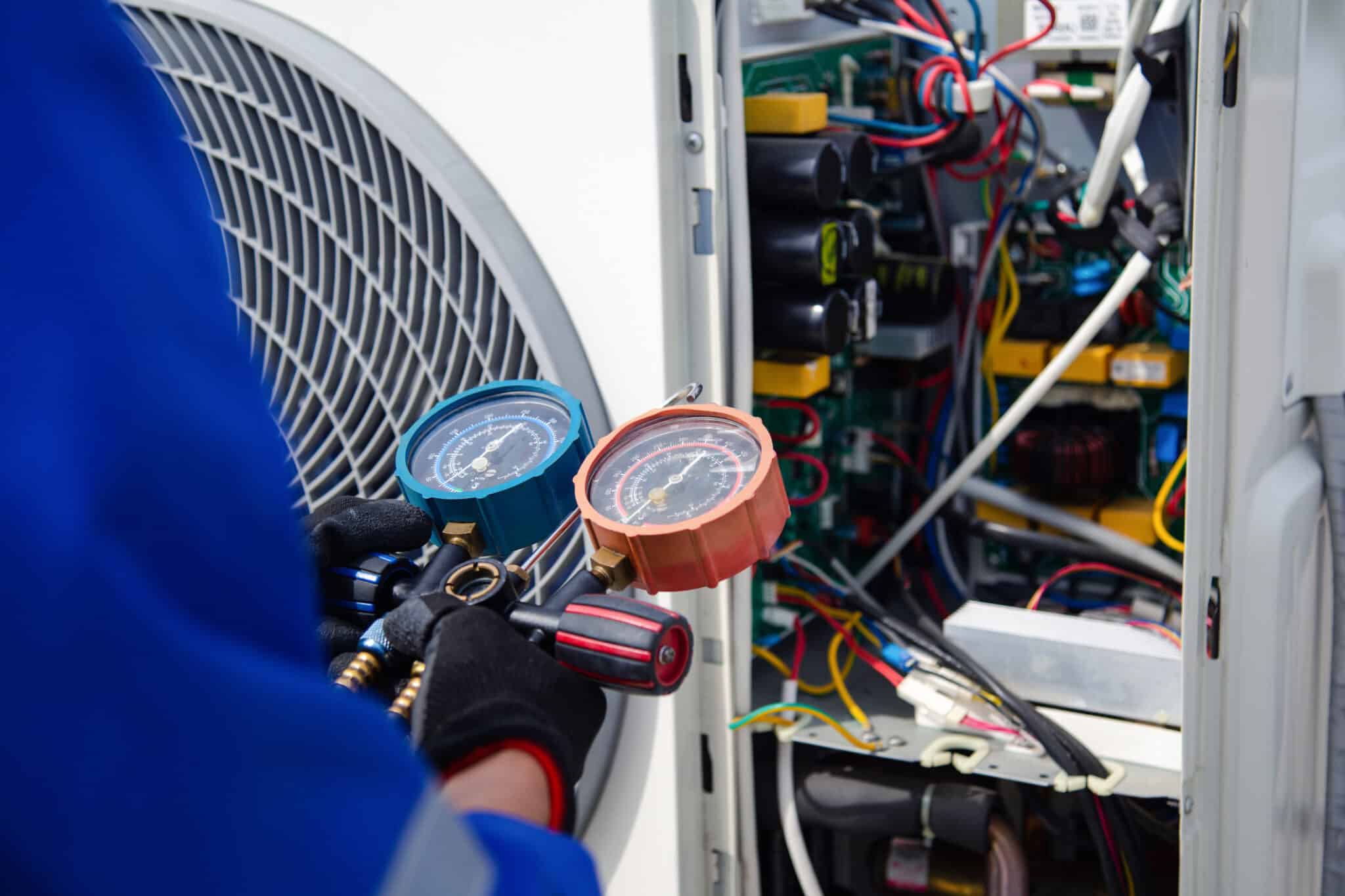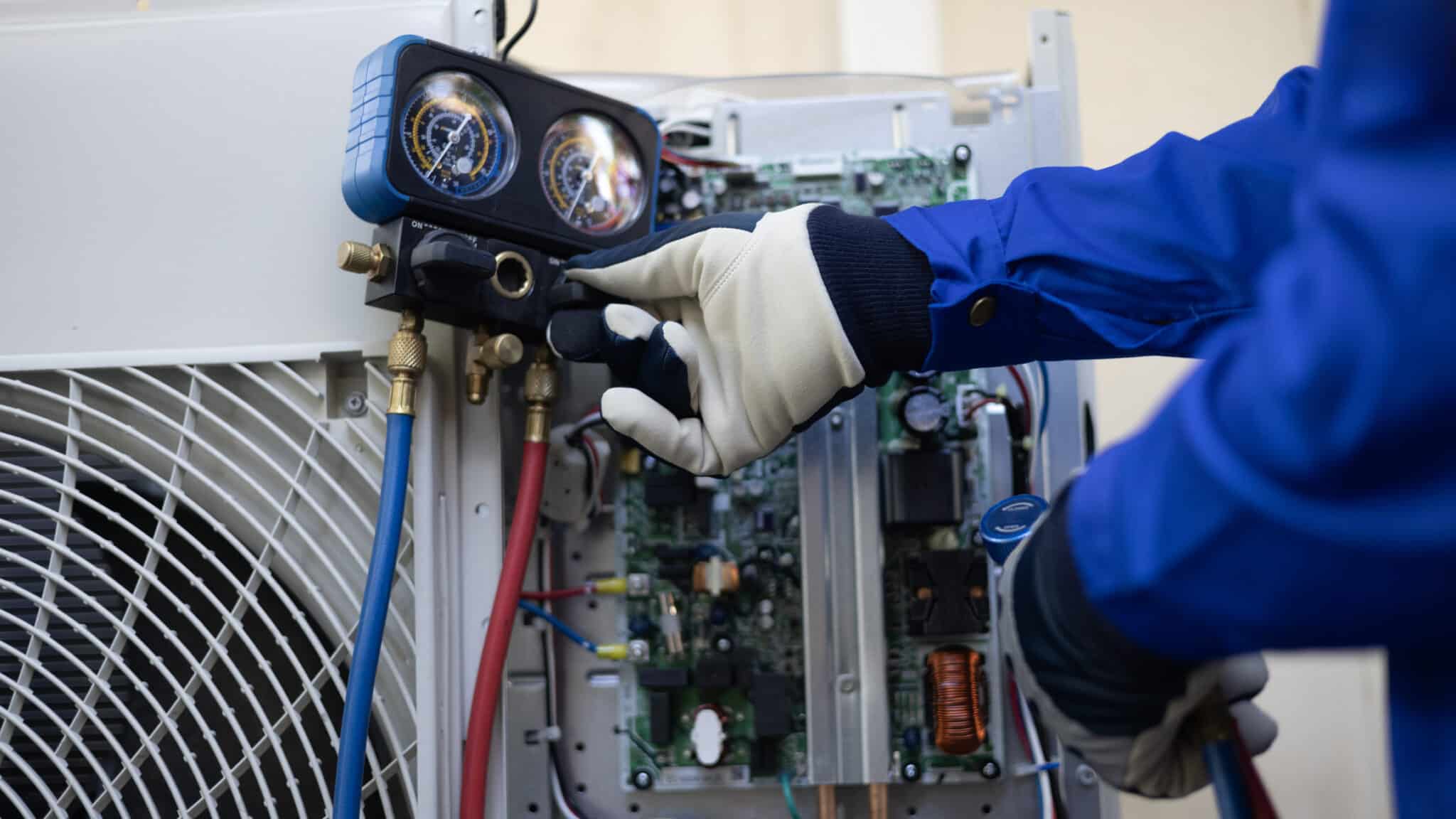HVAC System Inspection ensures your HVAC system is in prime condition, which is crucial for maintaining a comfortable home environment in Springtown, TX, and beyond. An HVAC system inspection is not just about checking if the system turns on and off. It’s about ensuring every component works efficiently and safely, from the thermostat settings to the air filters. This process helps identify potential issues before they escalate, saving you from unexpected breakdowns.
Residents of Paradise, TX, understand the importance of a well-functioning HVAC system, especially during the extremes of summer and winter. A thorough HVAC system inspection can reveal hidden problems that, if left unchecked, could lead to costly repairs or even complete system failure. Regular inspections ensure your system runs smoothly, providing peace of mind and comfort throughout the year.
But what does a comprehensive HVAC system inspection entail? It’s more than a quick glance at your heating and cooling units. It involves a detailed examination of all system components, ensuring they’re not only operational but also efficient and safe. This checklist is your guide to understanding what professionals look for during an inspection, ensuring your system’s longevity.
Whether you’re in Springtown, TX, Paradise, TX, or anywhere in between, taking the time for an HVAC system inspection is a wise decision. It not only ensures your system’s efficiency and safety but also contributes to its longevity. By understanding what goes into a thorough inspection, you’re taking a proactive step in home maintenance, ensuring comfort and reliability year-round.
Understanding HVAC System Inspection Basics
Understanding the basics of an HVAC system inspection is essential for homeowners in Springtown, TX, and beyond. At its core, this process involves a professional evaluating the system to ensure every component operates as it should. This means checking if the thermostat responds correctly, the air filters are clean and efficient, and the system’s overall performance meets safety standards. Such inspections are crucial for identifying issues early, preventing minor problems from becoming major headaches.
During an inspection, professionals also focus on the system’s efficiency. They examine the heating and cooling units to ensure they’re not working harder than necessary, which can lead to increased energy usage. This step is vital for maintaining an environmentally friendly home and keeping utility bills in check. By ensuring your system runs efficiently, you’re also extending its lifespan, making it a wise investment for comfort and sustainability.
Safety is another critical aspect of an HVAC system inspection. Technicians look for any signs of wear and tear that could pose risks, such as electrical issues or leaks. In places like Paradise, TX, where weather conditions can put a strain on HVAC systems, ensuring your unit is safe is paramount. This not only protects your home from potential hazards but also ensures the air quality remains high, contributing to a healthier living environment.
Lastly, a thorough inspection includes checking the system’s ductwork and ventilation. Proper airflow is essential for an HVAC system to function correctly, distributing air evenly throughout your home. Blocked or leaky ducts can lead to inefficiencies and uneven heating or cooling, impacting your comfort. By addressing these issues during an inspection, you ensure your HVAC system operates optimally, keeping your home comfortable in every season.

Pre-Inspection Checklist: What You Need Before Starting
Before initiating an HVAC system inspection, creating a pre-inspection checklist is a smart move. This ensures you’re well-prepared when a professional arrives, making the process smoother and more efficient. Your checklist should include verifying that all accessible parts of the system are unobstructed. This preparation allows the technician to easily examine your unit, saving time and facilitating a thorough review.
Next, ensure your thermostat settings are normal, as this is the starting point for many inspections. It’s important for the technician to observe how your HVAC system responds to thermostat commands. If possible, note any irregularities in heating or cooling patterns beforehand. Sharing this information can help pinpoint potential issues more quickly, enhancing the inspection’s effectiveness.
Having a record of past maintenance and repairs can significantly aid the inspection process. This history provides the technician with valuable insights into your system’s condition and any recurring problems. It’s beneficial to gather any documents or notes related to previous services or repairs. This preparation enables a more focused inspection, targeting areas of concern identified in past assessments.
Finally, checking your air filters and replacing them if dirty is crucial before the inspection. Clean filters not only improve air quality but also allow the HVAC system to operate more efficiently. Informing the technician of the last time filters were changed offers a clearer picture of your system’s maintenance routine. This step is essential in ensuring your HVAC system inspection is as comprehensive and effective as possible.
Inspecting the Air Filters: A Critical Step
Inspecting the air filters is a crucial step in the HVAC system inspection process. It’s the first line of defense in maintaining indoor air quality and system efficiency. Dirty filters can significantly hinder performance, causing the system to work harder. This not only impacts the air you breathe but can also strain your HVAC, leading to potential issues.
During an inspection, professionals carefully examine the filters to ensure they are clean and properly fitted. If filters are clogged, they restrict airflow, which can affect the system’s ability to heat or cool your home efficiently. A clean filter supports optimal airflow, which is essential for maintaining comfortable temperatures in Springtown, TX, homes.
Replacing air filters is a simple yet effective way to improve your HVAC system’s efficiency and longevity. It’s recommended to change them regularly, depending on usage and the type of filter. This practice helps in preventing dust, pollen, and other particles from circulating through your home, ensuring a healthier living environment.
Technicians also advise homeowners on the best type of filters for their specific system during an HVAC system inspection. Choosing the right filter can make a significant difference in air quality and system performance. With proper guidance, homeowners in Paradise, TX, can maintain their HVAC systems in top condition, ensuring a comfortable and healthy home year-round.
HVAC System Inspection: Examining the Thermostat
After inspecting the air filters, the next crucial step in an HVAC system inspection is examining the thermostat. This device acts as the command center for your heating and cooling system, ensuring your home maintains the desired temperature. A properly functioning thermostat can significantly enhance your system’s efficiency. During the inspection, professionals check to ensure the thermostat accurately reads temperatures and responds correctly to settings adjustments.
Issues with the thermostat, such as incorrect temperature readings or delayed response to settings changes, can indicate underlying problems with the HVAC system. Technicians in Springtown, TX, use specialized tools to diagnose these issues. They may also offer advice on upgrading to programmable or smart thermostats, which can improve efficiency and comfort. This step is crucial for maintaining an optimal home environment, especially during the extreme temperatures experienced in areas like Paradise, TX.
Regularly testing the thermostat as part of your HVAC system inspection can prevent unexpected system failures. Homeowners are encouraged to note any irregularities in their system’s response to thermostat adjustments. Reporting these observations during the inspection can help professionals quickly identify and rectify issues, ensuring your system operates smoothly.
Lastly, understanding the role of the thermostat in your HVAC system’s overall performance is key. It not only controls the temperature but also plays a significant part in energy consumption. By ensuring it works correctly, you can maintain a comfortable, energy-efficient home. This aspect of the HVAC system inspection is essential for prolonging the life of your system and ensuring it provides consistent comfort throughout the year.
Checking the Ductwork for Leaks and Obstructions
After ensuring the thermostat is in proper working order, the next vital step in an HVAC system inspection is to examine the ductwork. look for any signs of leaks or obstructions that could impact the system’s efficiency. In Springtown, TX, where temperatures can vary greatly, maintaining an intact and clear ductwork system is crucial for keeping homes comfortable. This part of the inspection ensures that air flows freely and efficiently throughout the home.
Leaks in the ductwork can lead to significant energy waste and reduce the overall effectiveness of the HVAC system. During the inspection, technicians use specialized equipment to detect any leaks. If found, these issues can be addressed promptly, preventing further loss of efficiency. This is particularly important in areas like Paradise, TX, where the climate demands a high-performing HVAC system year-round.
Obstructions in the ductwork, such as dirt or debris, can also hinder the performance of an HVAC system. During an inspection, technicians carefully examine the ducts for any blockages that could restrict airflow. Clearing these obstructions is a key step in ensuring the system operates at its best. This not only improves air quality but also enhances the comfort of your home.
Finally, a thorough HVAC system inspection includes assessing the overall condition of the ductwork. This involves checking for any damage or wear and tear that could affect the system’s longevity. By identifying and addressing these issues early, homeowners in Springtown, TX, and beyond can ensure their HVAC systems remain reliable and efficient. This proactive approach to maintenance is essential for achieving optimal performance and extending the life of the system.
Inspecting Outdoor Units: Condenser and Compressor
Inspecting the outdoor units, specifically the condenser and compressor, is a crucial part of any HVAC system inspection. These components play a vital role in cooling your home, especially during the hot summers in Paradise, TX. Technicians check for any signs of damage or wear that could impair their function. Ensuring these units are in good condition helps maintain your system’s efficiency and reliability.
During the inspection, the cleanliness of the outdoor units is also assessed. Leaves, dirt, and debris can accumulate, obstructing airflow and reducing the system’s performance. Professionals in Springtown, TX, will clear away any blockages, allowing the system to operate more smoothly. This step is essential for preventing overheating and ensuring the longevity of the HVAC system.
Another important aspect is checking the refrigerant levels in the compressor. Adequate refrigerant is necessary for the HVAC system to cool your home effectively. If levels are low, it could indicate a leak, which requires immediate attention. Technicians use specialized tools to measure the refrigerant and ensure it’s at the optimal level for your system’s operation.
Finally, the electrical connections and controls of the outdoor units are examined. Faulty wiring or controls can lead to inefficiencies or even pose safety hazards. By thoroughly inspecting these components, professionals ensure that your HVAC system is safe to use. This meticulous approach to the inspection process guarantees that your system in Springtown, TX, remains in top condition, providing comfort and peace of mind.
HVAC System Inspection: Evaluating the Electrical Connections
Evaluating the electrical connections is a pivotal part of an HVAC system inspection, ensuring everything operates safely and efficiently. In Springtown, TX, professionals meticulously check each connection for signs of wear or corrosion. This step is critical as faulty wiring can lead to system malfunctions or pose a fire hazard. By catching these issues early, homeowners can avoid unexpected system failures and ensure their HVAC runs smoothly.
During the inspection, technicians also focus on the system’s controls and switches. They verify that each component responds correctly, ensuring the HVAC system can be operated safely. This includes testing the thermostat’s communication with the system, a key factor in maintaining the desired home temperature. Such thorough checks are essential for the system’s reliability, especially in the varying climates of Paradise, TX.
Another important aspect is assessing the electrical connections to the outdoor units. Professionals ensure these are secure and protected from the elements, which is vital for preventing short circuits. Proper insulation and sealing against moisture are checked to safeguard the system’s electrical components. This attention to detail extends the lifespan of the HVAC system, providing homeowners peace of mind.
Finally, the inspection includes a review of the system’s safety features, such as circuit breakers and emergency shut-offs. Technicians ensure these are in working order, providing an added layer of protection for the household. By thoroughly evaluating the electrical connections and safety features, an HVAC system inspection guarantees a safe, efficient, and reliable heating and cooling experience for residents of Springtown, TX, and beyond.
Seasonal Maintenance Tips for Your HVAC System
To keep your HVAC system in top shape, seasonal maintenance is essential. As seasons change in Springtown, TX, preparing your system can prevent unexpected failures. Checking your system in spring and fall ensures it’s ready for the extreme temperatures of summer and winter. This routine care is a key step in extending the life of your HVAC system.
In Paradise, TX, homeowners should focus on clearing any debris around outdoor units each season. Leaves, twigs, and dirt can accumulate, obstructing airflow and reducing efficiency. Ensuring these areas are clean enhances your system’s performance and prevents overheating. Regular cleaning is a simple yet effective way to maintain your HVAC system’s health.
Another seasonal tip is to listen for unusual noises during operation. Strange sounds can indicate potential problems within your HVAC system. Addressing these noises early on can prevent minor issues from becoming major repairs. It’s a proactive approach that keeps your system running smoothly throughout the year.
Lastly, scheduling a professional HVAC system inspection before the peak of summer or winter is wise. A technician can spot issues that might not be visible to the untrained eye. This preemptive step ensures your system operates efficiently when you need it most, providing comfort and peace of mind.

Frequently Asked Questions
What is included in an HVAC System Inspection?
An HVAC system inspection covers several key areas to ensure your system runs smoothly. Technicians check the thermostat settings to match your comfort levels. They also examine electrical connections and test the system’s operation to guarantee safety and efficiency. Air filters get inspected and replaced if necessary, promoting better air quality. Lastly, the inspection includes cleaning components like coils and blowers to enhance performance.
How often should I inspect my HVAC system?
Experts recommend checking your HVAC system twice a year. Ideally, this should happen in spring and fall to prepare for extreme temperatures. Regular inspections help catch issues early, ensuring your system runs efficiently. This routine care extends the life of your HVAC, keeping your home comfortable year-round.
What tools are needed for HVAC inspection?
Professionals use a variety of tools for an HVAC system inspection to ensure everything is working correctly. They might use gauges to measure pressure and temperatures within the system. A multimeter helps check electrical connections and components for safety. Flashlights allow technicians to see in dark, tight spaces. Lastly, inspection mirrors can help view hard-to-reach areas without dismantling the entire system. These tools ensure a thorough check-up, keeping your HVAC in top condition.
Can I perform an HVAC System Inspection myself?
While you can perform a basic HVAC system inspection yourself, it’s wise to leave detailed checks to the professionals. They have the right tools and knowledge to spot potential issues you might miss. Simple tasks like replacing air filters or cleaning vents are doable on your own. However, for a thorough inspection, hiring an expert ensures your system operates efficiently and safely.
What are common issues found during inspections?
During HVAC system inspections, technicians often find dirty air filters, which can hinder airflow and reduce efficiency. They also discover worn electrical components that pose a risk to the system’s safety and operation. Leaks in the ductwork are another common issue, leading to energy loss and uneven heating or cooling. Lastly, improperly calibrated thermostats can cause discomfort and increased energy usage, highlighting the need for regular checks.








